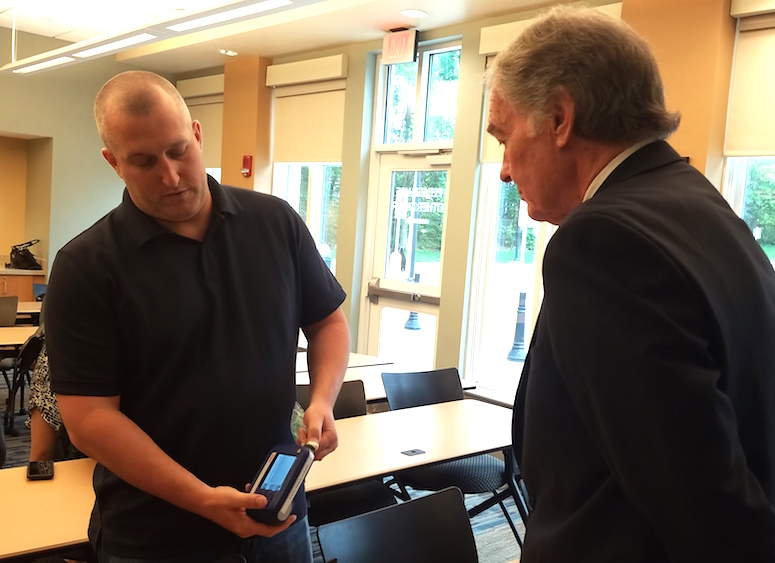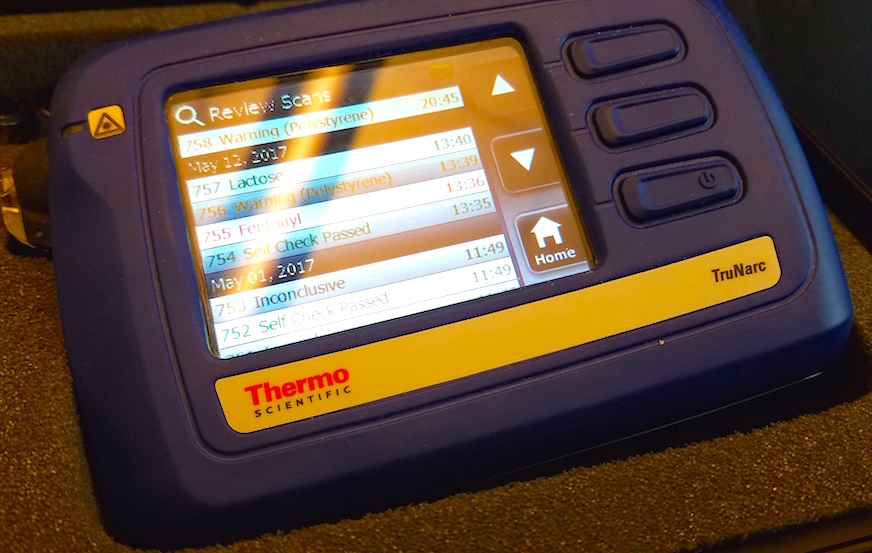
Charlie Breitrose
Sen. Edward Markey pushed for his legislation that would provide federal customs and border agents with handheld technology that can detect dangerous drugs such as fentanyl. Watertown currently has one of the devices. Also pictured are Watertown Police Chief Michael Lawn, left, Arlington Police Chief Fred Ryan and Middlesex Sheriff Peter Koutoujian.
Sen. Edward Markey visited Watertown to talk about legislation he has introduced that would provide border agents with the same technology to find illicit and dangerous drugs that the Watertown Police Department current uses.
In just a couple minutes a handheld device made by a company in Waltham can test a substance through a plastic bag or glass and let police know if it is something harmless like sugar or the lethal synthetic opioid, fentanyl.
The drug has replaced heroin as the drug of choice for many dealers and users in Massachusetts, but it is 50 times more powerful than heroin and can be deadly even if it just touches your skin. Recently an Ohio police officer overdosed on fentanyl which he was exposed to when he just brushed it off his uniform.
Last year, Massachusetts had an estimated 2,069 opioid related deaths and nearly 70 percent of them involved fentanyl, putting the state the second highest per capita for synthetic opioid related deaths, behind New Hampshire, Markey said.
“Fentanyl the Godzilla of opioids. It is overrunning communities and laying waste to them,” Markey said. “There is no easy solution but we know we must staunch the flow of this drug before we lose an entire generation to this terrible opioid killer.”
Markey visited the Watertown Police Station Tuesday afternoon to talk the INTERDICT Act, which he co-sponsored with both Democrats and Republican Senators, including Florida’s Marco Rubio. The legislation would provide $15 million to purchase high tech devices to detect drugs and provide more resources to U.S. Customs and Border Protection agents. He was joined by Middlesex District Attorney Marian Ryan, Middlesex Sheriff Peter Koutoujian, Watertown Police Chief Michael Lawn, Watertown Town Manager Michael Driscoll, Arlington Police Chief Fred Ryan and John Rosenthal, who heads the Police Assisted Addiction and Recovery Initiative (PAARI).

Charlie Breitrose
Watertown Detective John Bartolomucci demonstrates how the handheld device works for Sen. Edward Markey at the Watertown Police Station.
Each of the portable handheld devices made by Thermo Fisher Scientific of Waltham costs $30,000, and so the INTERDICT legislation could purchase many for the Customs and Border agents to use. Ryan said ports of entry, such as Logan Airport, are one of the primary ways which fentanyl is coming to the U.S., shipped in from China. Another way it gets into the country is by people smuggling it in from Mexico, Markey said.
“This is the kind of device which our law enforcement officials need,” Markey said. “We can try to build a $25 billion wall across our southern border, but these devices would be much more useful in terms of our law enforcement agency’s abilities to detect these deadly drugs (and from) getting into our country.”
Watertown has had one of the devices for about a year, and Detective John Bartolomucci said between the WPD and the Federal Organized Crime Drug Enforcement Task Force, of which he is part, the device is used at least once a week.
“It can tell you whatever it is,” Bartolomucci said. “It can tell you if it is a drug or it it not a drug. We get sugar all the time.”

Charlie Breitrose
The handheld drug detection device shows the results of recent scans – including the synthetic opioid fentanyl. It is made by Thermo Fisher Scientific of Waltham.
Police began seeing fentanyl in the Watertown area about a year ago, but at first it was mixed in with heroin, Bartolomucci said. Now it is being found in the pure form, Koutoujian said. The powder is almost indistinguishable from heroin, however, Ryan added.
Lawn said the devices help protect his officers, and speed up investigations.
“The test kits we used to use you had to open the package, take some out and place it into tubes,” Lawn said. “It reduces exposure. You don’t even have to open the bag.”
Ryan said when a substance is sent to a lab for testing, the investigation stops. The devices give an answer within minutes.